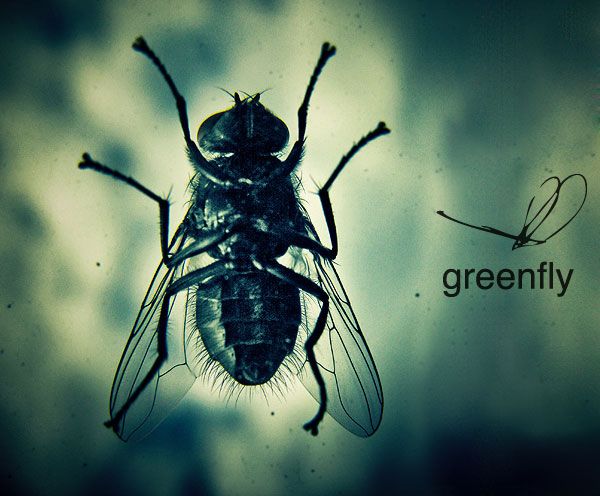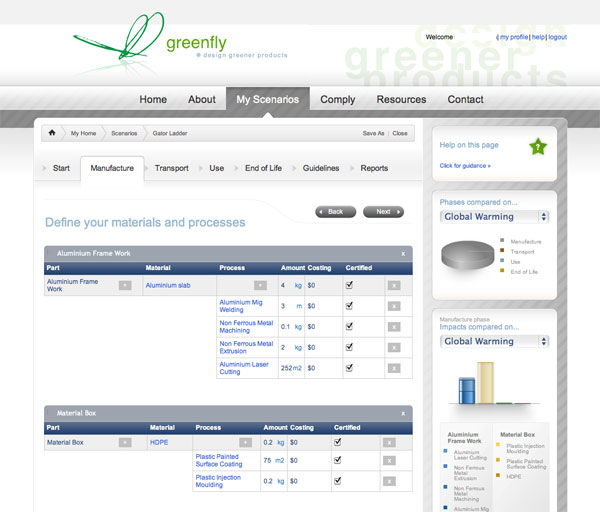Review – Sustainable Product Design with Greenfly

‘Sustainable design’ has got to be the most over-used term in the product design industry for the last couple of years, and by the look of things it is going to get worse the next couple of decades. We are inundated with sustainable this and sustainable that and company after company releasing a green policy and a green twist on every product they release. We all know however that these minute environmentally friendly changes have been going on in the background long before the green revolution. It’s about time that businesses and product designers got serious about sustainable design. Greenfly is one such solution, an account based website that allows you to create projects and estimate and analyse the implications your product has on the environment.
What is Greenfly?
Greenfly is an online based software developed by the Centre of Design and RMIT with financial support from Sustainability Victoria which aims to reduce the carbon footprint of product designs (http://www.greenflyonline.org/). Greenfly is still in Beta and has been for a couple of years now, but the most enticing part about the website is that Greenfly is totally free to use.
Once you have registered and setup an account Greenfly takes you through a 5 step process which requires you to fill out information through a tab based form. The 5 steps include:
- Create a scenario by giving a brief summary about your project and its sustainability goals
- Define the materials required to make up your product including its weight, and manufacturing processes required for each material
- Define the methods of transport and the distance required of these transport means in the assembly and distribution of your product
- Specify the energy used by your product when it is in operation by the end-user
- Define the end-of-life destination of components in your product
Once this information has been filled in an analysis report will be generated automatically specifying the environmental impacts of your product and how you could improve it. The user-interface of the program is fantastic and very easy to follow it even allows you to save progress as you go.
How it Could be Used
Greenfly has many applications in industry. Firstly it could be given to clients with your proposed product solution, specifying the environmental impacts of your product and how you have optimised the design in response. This of course wont mean much to most clients but ones who have a real tenacity for environmental responsibility will really value the extra yard you have gone to improve the product.
Greenfly could be used internally as a way to evaluate environmental impacts of proposed solutions and compare them to one another. For example product x generates # of green house gases while product y generates # this many. Economically the tool could be used to evaluate energy used for different products. For example, during the use stage of product x, the user will save $# compared to product y.
The Good
The accuracy of the data you will get from Greenfly is as good as what you put into it. If you give Greenfly highly accurate information you will get astonishingly good data in return. For example, I was able to find out how much fuel would be used shipping an injection moulded component from Beijing to Sydney by defining the Km distance between the 2 cities. Greenfly gives you specific details on individual components but more importantly it gives you a good overall impact statement by classifying impacts into the lifecycle stages of a product (manufacture, transport, use, end of life).
The website has free downloadable PDF resources like a number of data sheets on the environmental impacts on particular materials, and sustainability guidelines.
The Bad
There are not many bad things about Greenfly, but more so future developments. For example it would be fantastic if a businesses could be certified as using the Greenfly Sustainable Product Analysis Standard. This would give a huge advantage to businesses who are actually serious about sustainable design and will weed out the greenwashing companies.
The biggest improvement that could be made to Greenfly is a better way to get the data off their website and into a program like Microsoft Word or Excel or even a PDF. At the moment you have to copy and paste this information from their website and into your programs. The diagrams they use to explain your data are cheesy Microsoft Word 2003 styled diagrams that are an image file. So if you wanted a bigger version of their diagram or you wanted to make it look pretty it all has to be recreated manually in your program of choice. Many businesses will also be uncomfortable that all data is stored on the Greenfly website and if the program is removed all project data will be essentially lost for ever.
A good future development would being able to use Greenfly as a plugin in 3D modelling program like Solidworks or Rhino so all the component weightings and materials can be automatically calculated so it’s ready for Greenfly analysis.
Our Rating



5 Comments
I have never heard of this website before if I get some time I might check it out sounds pretty good!
greenfly is a good tool i have been using it ever since it came out as i used to go to rmit. it hasn’t been updated in ages though which is a real shame. they have probably been spending their time figuring out how to make it into a full fledged desktop program and charge hundreds of dollars for it.
yeah something like this needs to be integrated with cad programs big time – that would be gold
[…] Sustainable Product Design with Greenfly […]
[…] on. To take the difficulty out of this evaluation I highly recommend a free online program called Greenfly which I have reviewed in a previous […]